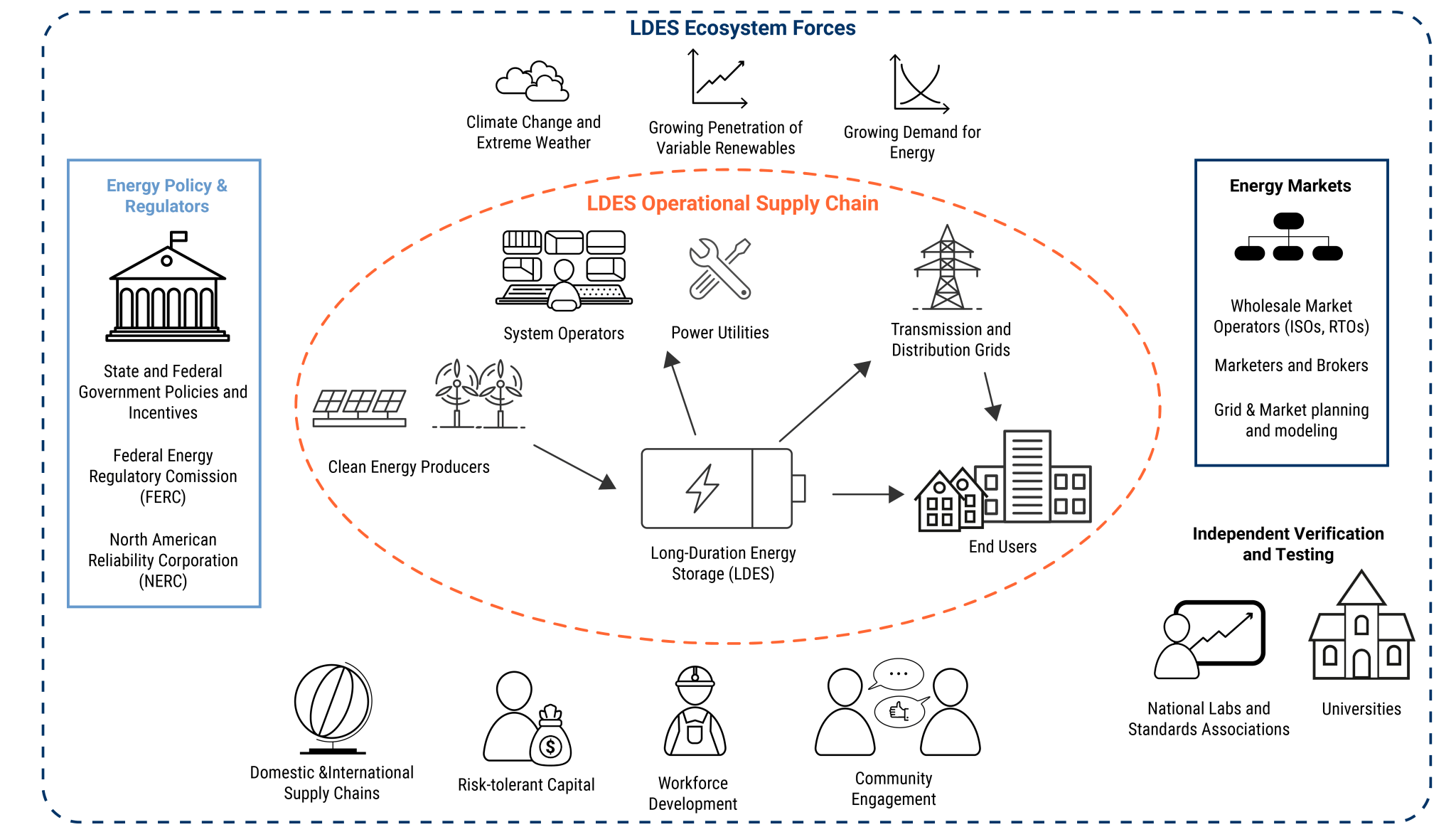Long Duration Energy Storage Working Group
Long duration energy storage (LDES) technologies can play an important role in helping balance energy supply and demand, especially as more variable renewables are added onto the grid. The technology’s flexibility allows it to serve various use cases while enhancing the overall reliability and resilience of the power system. The working group convenes companies across the LDES value chain, including utilities, LDES technology developers, power market operators, and other power sector stakeholders. This working group is currently focused on mechanical (e.g., compressed air energy storage) and electrochemical (e.g., flow batteries) LDES technology types with a duration of dispatch greater than ten hours.
Variable renewable electricity is being added to the U.S. power grid in record amounts, while dispatchable fossil fuel-fired power plants are being retired. At the same time, electric demand is increasing from AI-capable data centers, a reshoring of manufacturing, and electrification of many end uses (e.g., electric vehicles, heat pumps). Exacerbating this supply-demand shift, climate change is impacting the number of grid stress events (i.e., the intensity, frequency, and duration of extreme weather events is increasing). This has catalyzed the energy storage market, which has grown exponentially year-over-year since 2020. However, storage growth has been dominated by lower cost and shorter duration lithium-ion batteries (typically 0 to 4 hours).
While lithium-ion batteries will continue to play an essential role in daily electricity management, they are unlikely to become economic in the power sector at longer durations and may be better suited for other use cases (i.e., electric vehicles). LDES can play a critical role in enabling higher penetration of renewables, enhancing grid resilience, reducing use of natural gas peaker plants, and diversifying the domestic energy storage supply chain. However, the economic and environmental benefits of LDES have yet to be captured in most grid planning, power market, and energy modeling activities. Furthermore, there are few, if any, LDES carveouts or policies in state electricity portfolio standards, state climate action plans, or utility integrated resource plans. These gaps, combined with first-of-a-kind deployment costs, make it challenging for utilities and Public Utility Commissions (PUCs) to make an economic case for LDES.
According to the U.S. Department of Energy, the grid may need to add 225 to 460 gigawatts of LDES capacity to support a net-zero economy by 2050. This assumes total deployment of 4 to 13 gigawatts of LDES by 2035 (Source: DOE). Near-term, near-commercial scale demonstrations of LDES will be essential to driving down the levelized cost of LDES and producing the data, cost-savings, and operational insights that grid managers will need in the long-term. Federal and state-level decision-makers can play a critical role by ensuring that power markets and energy regulation will effectively enable widespread and coordinated deployment and commercialization of LDES.
- Create a venue for utilities, inter-day and multi-day LDES providers, Independent System Operators/Regional Transmission Organizations (ISOs/RTOs), and other power sector stakeholders to convene and identify a shortlist of policy and market solutions that can help address the current barriers to LDES deployment while simultaneously enhancing key value drivers.
- Work with participating companies to educate key decisionmakers at the federal and subnational levels about the importance of policies to support LDES deployment. Key decisionmakers include federally regulated entities such as ISOs and RTOs; federal agencies like the Federal Energy Regulatory Commission (FERC); the White House and Congress; state PUCs; state legislatures; and electric utilities.
- Align, to the extent practicable, on a shared vision around the policies and market mechanisms needed to enable deployment of LDES technologies in the power sector and collectively work towards the enactment of those policies.
- Strengthen connectivity and collaboration across the LDES innovation ecosystem.
The Long Duration Energy Storage Ecosystem

The long duration energy storage ecosystem: Includes key components of the supply chain as well as important ecosystem forces. The ecosystem forces include market, policy, local and global factors that will influence the long-term success of the LDES industry. LDES is any system that can store energy for ten or more hours. It is a diverse technology class with a range of potential system types, including electrochemical, mechanical, chemical, and thermal energy storage. The first year of the LDES working group is focused on electrochemical and mechanical LDES.
Policy Recommendations to Unlock the Value of Long-Duration Energy Storage
Long-duration energy storage (LDES) will play an increasingly important role in decarbonizing the power sector as more variable renewable energy is added to the electric power grid. This brief offers a shortlist of five policy recommendations following the inaugural year of the Long-Duration Energy Storage Technology Working Group.
Read the Brief
Taking the Long View: Unlocking the Value of Long-Duration Energy Storage
C2ES Innovation Manager Johanna Wassermann explores the critical role of long-duration energy storage (LDES) in transforming the United States power sector by reforming resource adequacy frameworks, creating state-level procurement targets, supporting federal demonstration projects, and potentially implementing economy-wide carbon pricing to drive clean energy innovation.
Read the Blog
More on Long Duration Energy Storage

